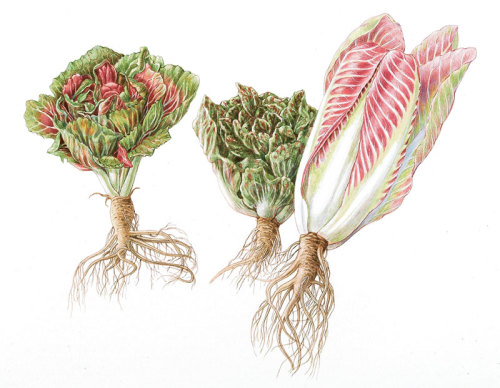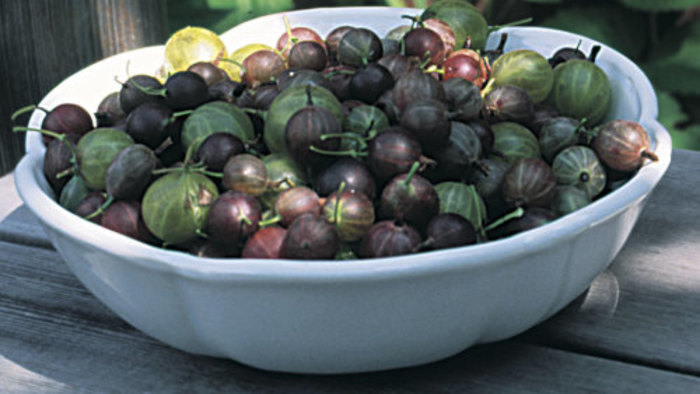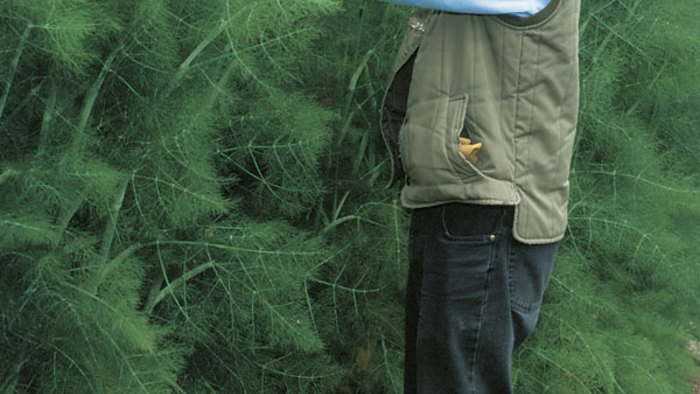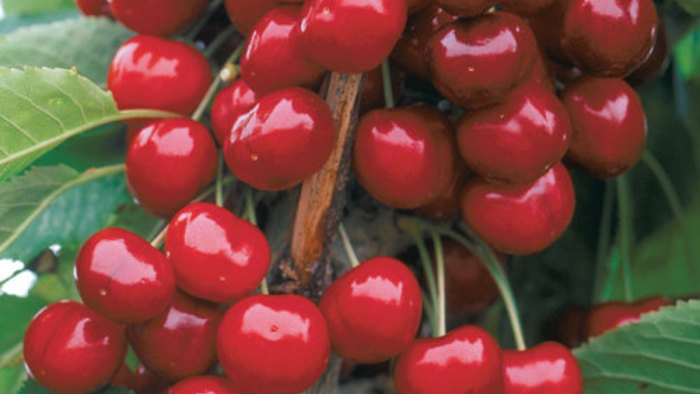
by Jean Hendrick
December 1997
from issue #12
I was living in Annapolis when the New American cuisine swept in from the West Coast. Cooking and gardening were my passions, so I embraced this new style with its emphasis on impeccably fresh, full-of-flavor food. I harvested from my small garden or shopped the central market in downtown Annapolis for the best produce I could find. I perused cookbooks, reinterpreted recipes, and created wonderful food for my catering business and restaurant.
I served a variety of salad greens—mâche, arugula, mizuna, and radicchio. Beautiful, bitter, red-and-white radicchio was a revelation. Its intriguing flavor—with a bite—combined well with milder lettuces and greens, all enhanced by just a touch of balsamic vinegar.
When I later moved to Maine and bought a country inn, I brought the New American cuisine with me. Finding garden-fresh ingredients was another matter. Radicchio was not to be seen at our local grocery store, nor even at a larger one 35 miles away. But I was hooked, so the only choice was to grow my own.
Choosing between the old world and the new
Radicchio is an Old World chicory. In Italy, the redheaded chicories are known as radicchios. There are heirloom varieties and there are modern cultivars. All grow best in cool or mild weather; all have an inclination to bolt. The traditional or heirloom varieties require around 100 days to mature. In regions where winter temperatures stay above 10˚F, radicchio can be planted in the fall and harvested in the spring. Newer hybrids have been developed for spring planting and a shorter growing season, so you can harvest radicchio before the summer’s gone.
‘Early Treviso’ and ‘Giulio’ are varieties that are less likely to bolt. Other varieties available include ‘Red Verona’, ‘Red Treviso’, and ‘Castelfranco’. All have slightly different shades of burgundy and garnet. They’re torpedo-shaped or rounded; days to maturity run from 80 to 100.
A difficult beginning. I started with the heirloom ‘Red Verona’, the commonly recognized variety. It’s a round redhead with white ribbing. The length of time to harvest is 100 days.
I prepared my soil for ‘Red Verona’ by turning the top foot over and adding compost, seaweed, and a scattering of 10-10-10. Radicchio isn’t fussy but it does like soil that’s rich, well-drained, and moist.
I planted ‘Red Verona’ seeds in rows 8 in. apart, covered them lightly with soil, and kept them damp during germination. After sprouts appeared, I thinned the seedlings to about 8 in. apart. (By the way, don’t be surprised when radicchio sprouts up green; this is typical and leaves will redden as they mature.) The plants grew to 12 in. high with large red and green leaves.
Around Labor Day, in great anticipation, I cut the plants back to within 1 in. of the ground and waited for leaves to resprout and heads to form. This should take four to siweeks. Well, the leaves grew back, but the heads would not form. By September, Maine’s sun was too weak and temperatures too low. I needed a variety with a shorter time to harvest; otherwise, I would have to somehow lengthen the season.
A happy ending. ‘Giulio’ is a variety that has been manipulated to produce beautiful heads in a short growing season. ‘Early Treviso’ and ‘Rossana’ are also early-maturing types. ‘Early Treviso’ reportedly can be seeded in mid-July. Planting in June or July means the plants are less likely to bolt, since they are smaller during the heat and sun of summer.
‘Giulio’ was developed for spring planting and matures in about 80 days. This time around, I started ‘Giulio’ in mid-April in flats in my greenhouse, in a starting medium called Pro-Mix. Night temperatures hovered around 50˚F and day temperatures averaged 70˚F. The seeds sprouted in three to five days, and I thinned the seedlings to one per 2-in. cubicle. I hardened the seedlings off for
three to four days, bringing them in each night. On June 1, the seedlings had reached 3 in., so I planted them 10 in. apart in full sun, adding liquid fertilizer to the planting holes.
‘Giulio’ grows about 6 in. high and 12 in. wide, forming bright red and white heads the size of softballs. They are ready to harvest when the heads are firm to the touch. For me, that’s around the middle of July. I can continue harvesting for about a month. Since the outer leaves of the plant are bitter, I cut only the head.
I have had a good harvest with ‘Giulio’ in both wet and dry summers. When Maine temperatures reach a constant 80˚F in late July and early August, ‘Giulio’ will begin to bolt, so I harvest it as soon as I find firm, well-formed, hardball-size heads.
In mid-August, I start my ‘Giulio’ seeds in plastic trays again; I transplant these into my unheated greenhouse in late September. I’ve also had luck planting the seed directly in the greenhouse in late August, thinning them to 3 in. to 4 in. apart. By Thanksgiving, I will be using small golf-ball size heads of radicchio julienned in salads or roasted with Deer Isle leg of lamb. These small heads are less bitter than the early, larger ones of summer.
By January the radicchio will have succumbed to the cold. No matter, it was very satisfying to have homegrown radicchio at Christmastime.
In the past couple of years, radicchio has made its way to that grocery store 35 miles distant. And I also can purchase it from wholesalers, along with other unusual salad greens. But, as any cook–gardener worth his or her salt knows, the fresher the ingredients, the better the dish.
Radicchio options
As this article was going to press, we learned that one breeder is replacing ‘Giulio’ with ‘Firebird’, a hybrid similar in stature, but deeper in color, and a more reliable producer. Other hybrids to be on the look out for are ‘Melrose’ (early maturing), ‘Rubicon’ (bolt resistant), and ‘Indigo’ (intensely colored). All should be available in 1998 seed catalogs.
Seed distributors and home growers are at the mercy of seed producers, who may discontinue a variety at will. As long as your favorite plant is not a hybrid, saving seed is a good way to ensure a future supply. Seeds saved from hybrids may be sterile or may not show the same characteristics as the parents’.
Taking the bitter with the sweet
Why do some greens, like radicchio and endive, taste good to us when bitter and others, like lettuce, do not?
According to Rob Johnston of Johnny’s Selected Seeds, there’s a lot of sugar in radicchio, but not in lettuce. Radicchio’s innate sweetness balances the bitterness and adds complexity. Of course, more bitter isn’t necessarily better; even radicchio can become unpalatable if grown in unfavorable conditions.
Salt suppresses most bitter compounds by interfering with the bitter receptors on your tongue, according to Gary Beauchamp, director of Monell Chemical Senses Center in Philadelphia. So when you salt something that’s bitter and then eat it, your tongue doesn’t detect as much bitterness, and other flavor components, like sweetness, come to the fore. If you’ve tasted radicchio neat and been put off, try tossing the leaves with a drizzle of olive oil and a pinch of salt, but no vinegar.
Sources
The Cook’s Garden
PO Box C5030
Warminster, PA 18974
800-457-9703
www.cooksgarden.com
Johnny’s Selected Seeds
955 Benton Avenue
Winslow, Maine 04901
877-564-6697
www.johnnyseeds.com

















Comments
Log in or create an account to post a comment.
Sign up Log in